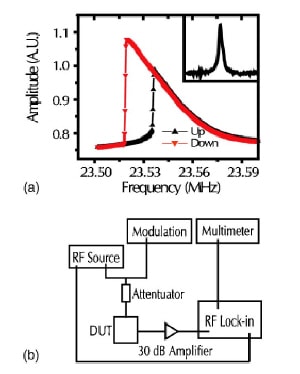Physicists in the US have made the first high-speed nanomechanical memory element from single-crystal silicon wafers. The device, developed by Pritiraj Mohanty and colleagues at Boston University, consists of a vibrating beam that can be made to switch between two distinct states. The team says its memory element could rival the current state-of-the-art in electronic data storage and processing (R L Badzey et al. 2004 Appl. Phys. Lett. 85 3587).

Mohanty and colleagues use standard electron lithography and surface nanomachining techniques to produce their beams, which are typically 8 microns long, 300 nanometres wide and 200 nanometres thick. To test a single device, they clamp a beam at both ends and then drive a megahertz frequency current through it, which causes the beam to vibrate at its resonant frequency.
When driven strongly enough, the beam switches between two different positions that can be used to represent “0” and “1” respectively. The two states can be seen as a hysteresis effect when the amplitude of the vibrations is plotted as a function of frequency (see figure).
The device has a resonant frequency of 23.57 megahertz, which means that information can be read more than 20 millions times per second, compared with the few hundred kilohertz rates that are possible in conventional computer hard drives. Nanomechanical memory elements could therefore overcome the superparamagnetic limits that apply to magnetic memories. Moreover, they could be packed together at densities that exceed the present maximum value of 100 gigabits per square inch.
“Another advantage of our memory element is its angstrom-sized ‘range of motion’, which allows it to operate using only femtowatts of power — compared to the milliwatts or microwatts of power that are needed for read-write functions in conventional machines,” Mohanty told PhysicsWeb. The team now hopes to make even smaller beams that will operate at gigahertz frequencies. It also plans to make nanomechanical structures from single-crystal diamond rather than silicon for better performance.



